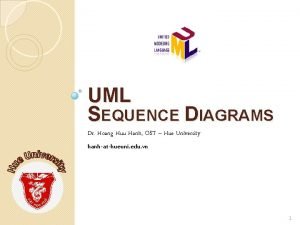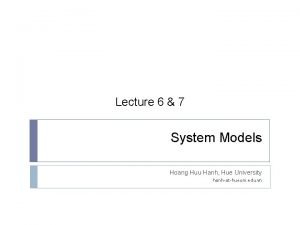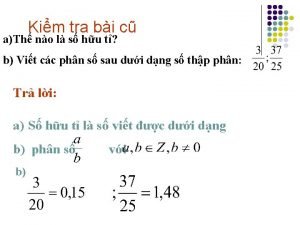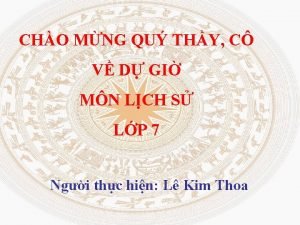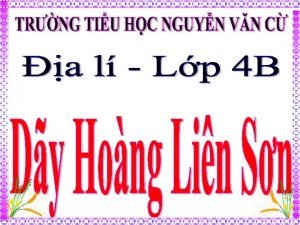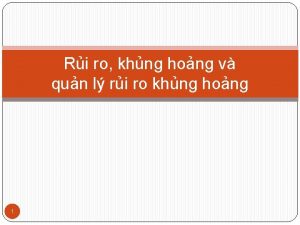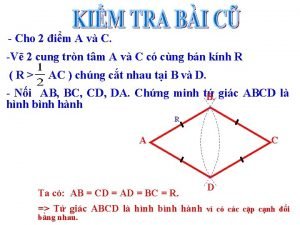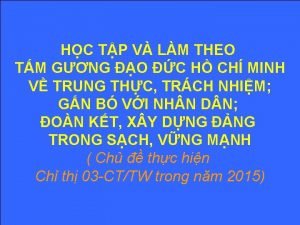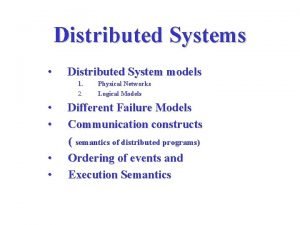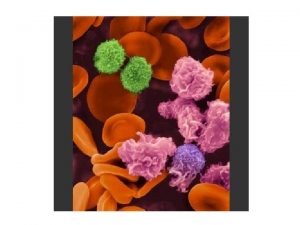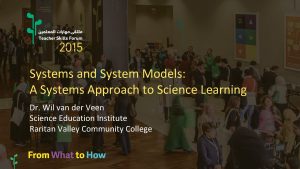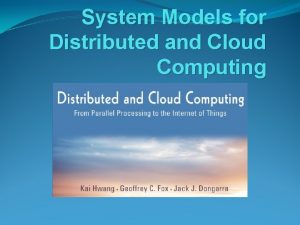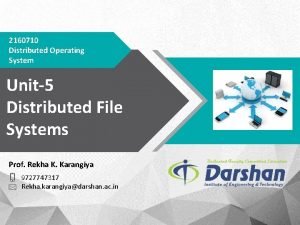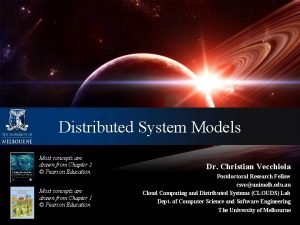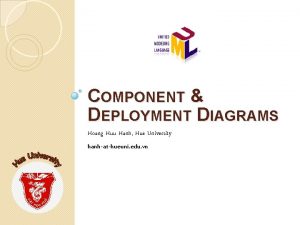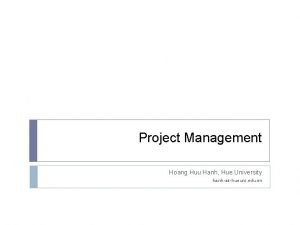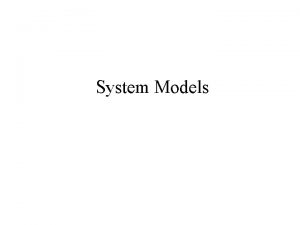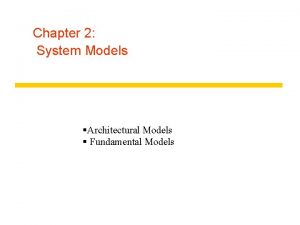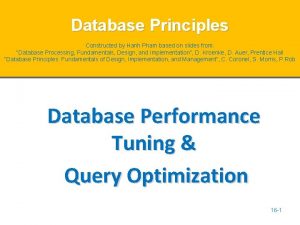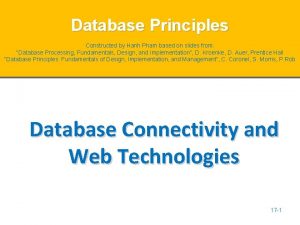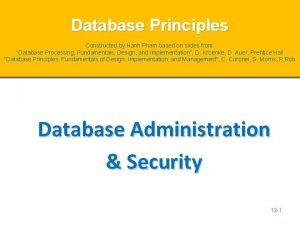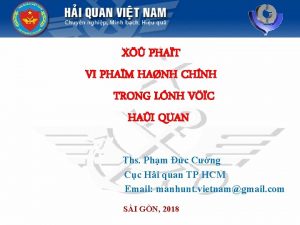Lecture 6 7 System Models Hoang Huu Hanh




































- Slides: 36

Lecture 6 & 7 System Models Hoang Huu Hanh, Hue University hanh-at-hueuni. edu. vn

System models are abstract descriptions of systems whose requirements are being analysed Objectives � To explain why the context of a system should be modelled as part of the RE process � To describe � Behavioural modelling (FSM, Petri-nets), � Data modelling and � Object modelling (Unified Modeling Language, UML) 2 System Models

System modelling � System modelling helps the analyst to understand the functionality of the system and models are used to communicate with customers � Different models present the system from different perspectives � External perspective showing the system’s context or environment � Behavioural perspective showing the behaviour of the system � Structural perspective showing the system or data architecture 3 System Models

System models weaknesses � They do not model non-functional system requirements � They do not usually include information about whether a method is appropriate for a given problem � They may produce too much documentation � The system models are sometimes too detailed and difficult for users to understand 4 System Models

Model types � Data processing model showing how the data is processed at different stages � Composition model showing how entities are composed of other entities � Architectural model showing principal sub-systems � Classification model showing how entities have common characteristics � Stimulus/response model showing the system’s reaction to events 5 System Models

1. Context models � Context models are used to illustrate the boundaries of a system � Social and organisational concerns may affect the decision on where to position system boundaries � Architectural models show the a system and its relationship with other systems 6 System Models

The context of an ATM system 7 System Models

Process models � Process models show the overall process and the processes that are supported by the system � Data flow models may be used to show the processes and the flow of information from one process to another 8 System Models

Equipment procurement process 9 System Models

2 Behavioural models � Behavioural models are used to describe the overall behaviour of a system � Two types of behavioural model � Data processing models that show data is processed as it moves through the system � State machine models that show the systems response to events � Both of these models are required for a description of the system’s behaviour 10 System Models

2. 1 Data-processing models � Data flow diagrams are used to model the system’s data processing � These show the processing steps as data flows through a system � IMPORTANT part of many analysis methods � Simple and intuitive notation that customers can understand � Show end-to-end processing of data 11 System Models

Order processing DFD 12 System Models

Data flow diagrams � DFDs model the system from a functional perspective � Tracking and documenting how the data associated with a process is helpful to develop an overall understanding of the system � Data flow diagrams may also be used in showing the data exchange between a system and other systems in its environment 13 System Models

2. 2 State machine models � State Machine models the behaviour of the system in response to external and internal events � They show the system’s responses to stimuli so are often used for modelling real-time systems � State machine models show system states as nodes and events as arcs between these nodes. When an event occurs, the system moves from one state to another � Statecharts are an integral part of the UML 14 System Models

Microwave oven model State machine model does not show flow of data within the system 15 System Models

Microwave oven stimuli 16 System Models

Finite state machines Finite State Machines (FSM), also known as Finite State Automata (FSA) are models of the behaviours of a system or a complex object, with a limited number of defined conditions or modes, where mode transitions change with circumstance. 17 System Models

Finite state machines - Definition A model of computation consisting of � a set of states, � a start state, � an input alphabet, and � a transition function that maps input symbols and current states to a next state � Computation begins in the start state with an input string. It changes to new states depending on the transition function. � � 18 states define behaviour and may produce actions state transitions are movement from one state to another rules or conditions must be met to allow a state transition input events are either externally or internally generated, which may possibly trigger rules and lead to state transitions System Models

Variants of FSMs � There are many variants, for instance, � machines having actions (outputs) associated with transitions (Mealy machine) or states (Moore machine), � multiple start states, � transitions conditioned on no input symbol (a null) or more than one transition for a given symbol and state (nondeterministic finite state machine), � one or more states designated as accepting states (recognizer), etc. 19 System Models

Finite State Machines with Output (Mealy and Moore Machines) � Finite automata are like computers in that they receive input and process the input by changing states. The only output that we have seen finite automata produce so far is a yes/no at the end of processing. � We will now look at two models of finite automata that produce more output than a yes/no. 20 System Models

Moore machine � Basically a Moore machine is just a FA with two extras. 1. It has TWO alphabets, an input and output alphabet. 2. It has an output letter associated with each state. The machine writes the appropriate output letter as it enters each state. This machine might be considered as a "counting" machine. The output produced by the machine contains a 1 for each occurrence of the substring aab found in the input string. 21 System Models

Mealy machine � Mealy Machines are exactly as powerful as Moore machines (we can implement any Mealy machine using a Moore machine, and vice versa). � However, Mealy machines move the output function from the state to the transition. This turns out to be easier to deal with in practice, making Mealy machines more practical. 22 System Models

A Mealy machine produces output on a transition instead of on entry into a state. Transitions are labelled i/o where � � i is a character in the input alphabet and o is a character in the output alphabet. The following Mealy machine takes the one's complement of its binary input. In other words, it flips each digit from a 0 to a 1 or from a 1 to a 0. � Mealy machine are complete in the sense that there is a transition for each character in the input alphabet leaving every state. � There are no accept states in a Mealy machine because it is not a language recogniser, it is an output producer. Its output will be the same length as its input. 23 System Models

Statecharts � Allow the decomposition of a model into sub-models (see a figure) � A brief description of the actions is included following the ‘do’ in each state � Can be complemented by tables describing the states and the stimuli 24 System Models

Petri Nets Model � Petri Nets were developed originally by Carl Adam Petri, and were the subject of his dissertation in 1962. � Since then, Petri Nets and their concepts have been extended, developed, and applied in a variety of areas. � While the mathematical properties of Petri Nets are interesting and useful, the beginner will find that a good approach is to learn to model systems by constructing them graphically. 25 System Models

The Basics �A Petri Net is a collection of directed arcs connecting places and transitions. � Places may hold tokens. � The state or marking of a net is its assignment of tokens to places. Place with token P 1 Arc with capacity 1 Place T 1 Transition P 2 26 System Models

Capacity � Arcs have capacity 1 by default; if other than 1, the capacity is marked on the arc. � Places have infinite capacity by default. � Transitions have no capacity, and cannot store tokens at all. � Arcs can only connect places to transitions and vice versa. � A few other features and considerations will be added as we need them. 27 System Models

Enabled transitions and firing �A transition is enabled when the number of tokens in each of its input places is at least equal to the arc weight going from the place to the transition. � An enabled transition may fire at any time. 28 System Models

When arcs have different weights… � When fired, the tokens in the input places are moved to output places, according to arc weights and place capacities. � This results in a new marking of the net, a state description of all places. 29 System Models

A collection of primitive structures that occur in real systems 30 System Models

3. Semantic data models � Used to describe the logical structure of data processed by the system � Entity-relation-attribute model sets out the entities in the system, the relationships between these entities and the entity attributes � Widely used in database design. Can readily be implemented using relational databases � No specific notation provided in the UML but objects and associations can be used 31 System Models

Software design semantic model 32 System Models

Data dictionary entries Data dictionaries are lists of all of the names used in the system models. Descriptions of the entities, relationships and attributes are also included 33 System Models

4. Object models � Object models describe the system in terms of object classes � An object class is an abstraction over a set of objects with common attributes and the services (operations) provided by each object � Various object models may be produced � Inheritance models � Aggregation models � Interaction models 34 System Models

Object models � Natural ways of reflecting the real-world entities manipulated by the system � More abstract entities are more difficult to model using this approach � Object class identification is recognised as a difficult process requiring a deep understanding of the application domain � Object classes reflecting domain entities are reusable across systems 35 System Models

The Unified Modeling Language � Devised by the developers of widely used objectoriented analysis and design methods � Has become an effective standard for object-oriented modelling � Notation � Object classes are rectangles with the name at the top, attributes in the middle section and operations in the bottom section � Relationships between object classes (known as associations) are shown as lines linking objects � Inheritance is referred to as generalisation and is shown ‘upwards’ rather than ‘downwards’ in a hierarchy 36 System Models
 Huu hanh
Huu hanh Huu hanh
Huu hanh Nhất nam viết hữu thập nữ viết vô
Nhất nam viết hữu thập nữ viết vô Bi là số hữu tỉ
Bi là số hữu tỉ Chùa diên hựu
Chùa diên hựu Bảng điểm atropin
Bảng điểm atropin Chủ sở hữu mạng toàn cầu internet là hãng nào
Chủ sở hữu mạng toàn cầu internet là hãng nào Mẹ đứng đó khi hoàng hôn tím màu
Mẹ đứng đó khi hoàng hôn tím màu Ta hãy khẩn cầu cho đức giáo hoàng
Ta hãy khẩn cầu cho đức giáo hoàng Dãy hoàng liên sơn
Dãy hoàng liên sơn Dãy hoàng liên sơn
Dãy hoàng liên sơn Kìa trông huy hoàng vì sao
Kìa trông huy hoàng vì sao Quản trị rủi ro và khủng hoảng
Quản trị rủi ro và khủng hoảng đây là nước nào
đây là nước nào Bạch nhật y sơn tận
Bạch nhật y sơn tận 01:640:244 lecture notes - lecture 15: plat, idah, farad
01:640:244 lecture notes - lecture 15: plat, idah, farad Vua nào đại phá quân thanh tơi bời
Vua nào đại phá quân thanh tơi bời Sơ đồ nạp hệ điều hành
Sơ đồ nạp hệ điều hành Hành trình của bầy ong
Hành trình của bầy ong Hành trình của bầy ong
Hành trình của bầy ong Chứng minh hình bình hành
Chứng minh hình bình hành Thực hành một số thí nghiệm về enzim
Thực hành một số thí nghiệm về enzim Kích hoạt bảo hành mitsubishi electric
Kích hoạt bảo hành mitsubishi electric Bác đang cùng chúng cháu hành quân
Bác đang cùng chúng cháu hành quân Speech act definition
Speech act definition Modals differences
Modals differences System models in distributed system
System models in distributed system Power system dynamics and stability lecture notes
Power system dynamics and stability lecture notes Operating systems lecture notes
Operating systems lecture notes Power system analysis lecture notes
Power system analysis lecture notes Unified health management information system
Unified health management information system Lymphatic system function
Lymphatic system function Power system dynamics and stability lecture notes
Power system dynamics and stability lecture notes Systems and system models
Systems and system models Distributed system models in cloud computing
Distributed system models in cloud computing What allows the replication of only immutable files
What allows the replication of only immutable files Fundamental models of distributed system
Fundamental models of distributed system
